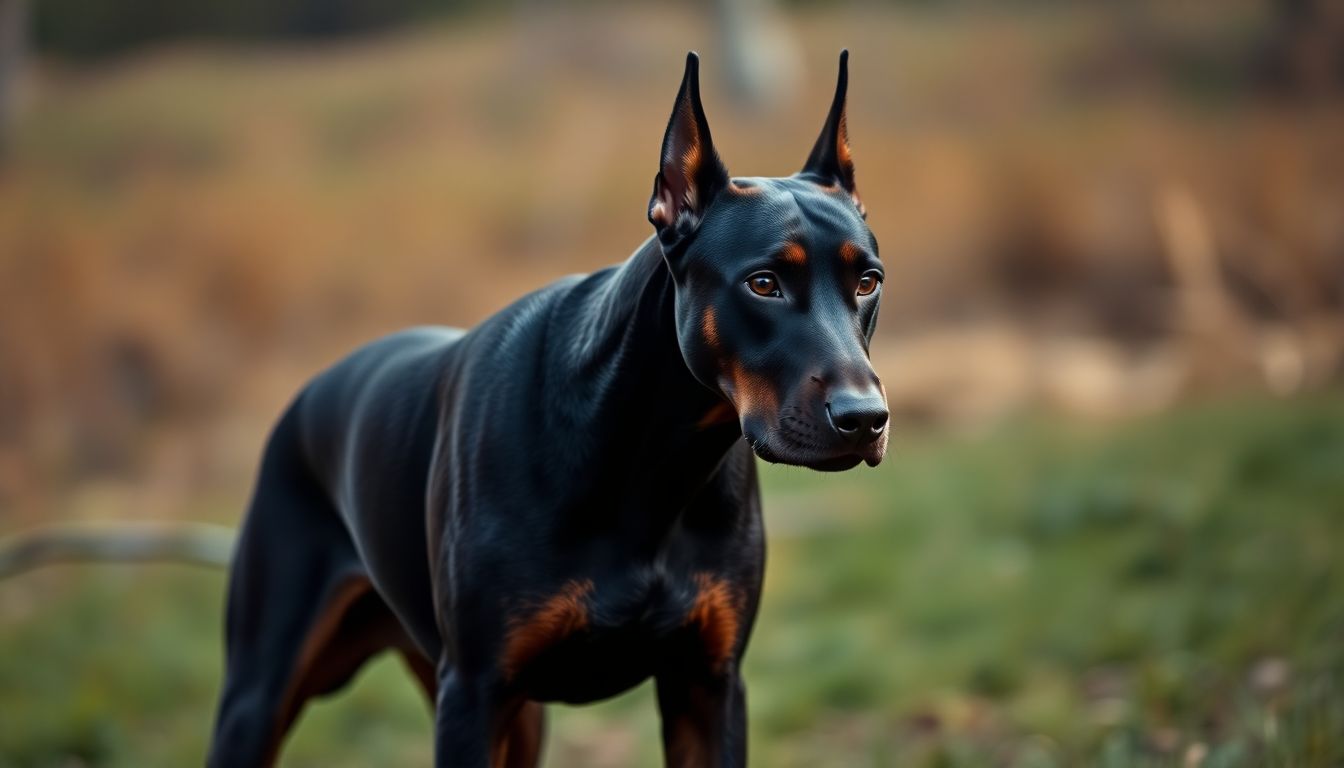
Dobermans. They're striking, powerful dogs with a reputation that can be a little scary. But beyond the image, lies a breed known for its smarts, loyalty, and protective nature. Want to learn more about these amazing dogs? Let's jump in!
Understanding the Doberman Pinscher: Origins and Breed Standards
This part gives you the basics. We'll look at where Dobermans came from and what makes them, well, Dobermans.
A Brief History of the Doberman Breed
Karl Friedrich Louis Dobermann, a tax collector in Germany, created the Doberman. He wanted a dog to protect him while he was working. That's why he mixed different breeds, like the Rottweiler and German Pinscher. The goal? To make the perfect guard dog.
Dobermans didn't just become protectors of tax collectors. They also became popular in law enforcement and the military. These dogs served their country with courage.
Doberman Pinscher Breed Standards: Size, Appearance, and Lifespan
The American Kennel Club (AKC) sets the standard for Dobermans. Males stand 26 to 28 inches tall. Females are a bit smaller, at 24 to 26 inches. Weight wise, expect males around 75 to 100 pounds and females 60 to 90 pounds.
Dobermans come in a few colors: black, red, blue, and fawn. All have rust-colored markings. The tail is often docked (shortened), and the ears are sometimes cropped (cut to stand erect). Cropping and docking spark debate. Some think it's cruel, while others believe it maintains the breed's look.
The average lifespan of a Doberman is 10 to 12 years. Certain health issues can affect this. We'll talk about these issues later.
Types of Dobermans: American vs. European
There are two main types of Dobermans: American and European. American Dobermans are often bred to be more elegant and are considered better for families. European Dobermans have a bulkier build. They also tend to be more intense. Breeders usually have a preference for one type over the other.
Doberman Temperament and Personality: Is a Doberman Right for You?
Dobermans have big personalities! Are they right for you and your family? Let's take a look.
The Intelligent and Trainable Doberman
Dobermans are smart cookies. They learn quickly and love to please. That makes training them easier. Positive reinforcement works best. Reward them with treats and praise when they do something right.
Early socialization is a must. Introduce your Doberman to different people, places, and situations when it's young. Dobermans excel in dog sports, like obedience and agility.
Loyalty and Protectiveness: The Doberman as a Family Companion
Dobermans bond closely with their families. They are very loyal. That protectiveness means they'll always have your back. Training is essential to manage those protective instincts.
Socializing a Doberman early can prevent issues, such as being aggressive with strangers. You want a dog that knows who is a friend and who is a foe.
Potential Challenges: Dominance and Exercise Needs
Dobermans can be dominant if you don't train them well. You'll need to be an experienced owner who can provide leadership. This means being consistent with rules and training. Dobermans need lots of exercise. Expect to give them daily walks, runs, and playtime.
Caring for Your Doberman: A Comprehensive Guide
Taking care of a Doberman is a big job. Here's what you need to know.
Doberman Diet and Nutrition: Fueling an Active Breed
A high-quality dog food is important. Choose one that's right for your Doberman's age and how active it is. Don't overfeed your dog, or they can get fat.
Some Dobermans have allergies or sensitivities. Keep an eye out for problems. Work with your vet to find a food that works. Some people feed their Dobermans a raw diet. This can be good, but you must be very careful about safety.
Exercise Requirements: Keeping Your Doberman Physically and Mentally Stimulated
Dobermans need lots of exercise. They love to run, swim, and play fetch. A good walk isn't always enough, get creative.
Mental stimulation is also key. Puzzle toys and training games can keep your Doberman entertained. Training keeps their mind active.
Grooming Your Doberman: Coat Care, Nail Trimming, and Dental Hygiene
Dobermans are pretty easy to groom. Brush them regularly to keep their coat shiny. They don't need baths too often. Only wash your dog when they get really dirty.
Trim their nails regularly, and don't forget their teeth! Dental hygiene is super important. Clean their teeth regularly to prevent problems.
Clean a Doberman's ears with cropped ears often. This will reduce the risk of infection.
Doberman Health Concerns: Common Issues and Preventative Care
Like all breeds, Dobermans are prone to certain health problems. Knowing about these issues can help you keep your dog healthy.
Common Health Problems in Dobermans
Some common health problems include:
- Dilated Cardiomyopathy (DCM): This is a heart condition.
- Wobbler Syndrome: Affects the spine.
- Von Willebrand's Disease: A bleeding disorder.
- Hip Dysplasia: A problem with the hip joint.
- Bloat: A dangerous condition where the stomach fills with gas.
Know the signs of these conditions. If you notice anything unusual, take your Doberman to the vet.
Preventative Care: Vaccinations, Parasite Control, and Regular Vet Checkups
Vaccinations are a must to protect your Doberman from diseases. Heartworm prevention and flea and tick control are also important. Take your Doberman for regular checkups with the vet. It can help catch issues early. Pet insurance can help with vet costs.
Genetic Testing and Responsible Breeding
Genetic testing can help breeders avoid passing on health problems. Support breeders who test their dogs and care about health.
Conclusion
Dobermans are amazing dogs. They're smart, loyal, and protective. But they need the right owner. Proper training, socialization, and care are key. Are you ready for a Doberman? Do your research, and think about your lifestyle. If you can provide what a Doberman needs, you'll have a wonderful companion for life.











0 Comments